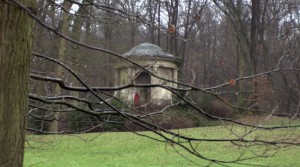 The other day I saw some stills from American artist Corey McCorkle’s video installation Hermitage, which takes as its subject a dilapidated leisure garden outside Paris called the Désert de Retz. The video shows people in contemporary dress walking among weathered architectural eccentricities trussed in vines and wisps of fog.
The other day I saw some stills from American artist Corey McCorkle’s video installation Hermitage, which takes as its subject a dilapidated leisure garden outside Paris called the Désert de Retz. The video shows people in contemporary dress walking among weathered architectural eccentricities trussed in vines and wisps of fog.
I was intrigued, so I did a little research. I learned that throughout the 18th and 19th centuries, the Désert de Retz was basically an Orientalist theme park, complete with a Chinese pavilion, an icehouse in the shape of an Egyptian pyramid, Tatar tents, and various other exotic knockoffs — altars, tombs, something called the “Temple of Repose,” etc. For over a century, French aristocrats and foreign nobility came to stay at the estate’s summerhouse, which was built in the image of a fractured Roman column.
Designed to resemble ruins, these follies have themselves fallen into ruin under a combination of mismanagement and a tapering of interest in European leisure gardens that coincided with the emergence of commercial expositions, concert halls, and amusement parks. The idiosyncratic structures appear in McCorkle’s film as weathered monuments to forgotten fantasies, reveries consigned to oblivion.
Much of McCorkle’s other work, I discovered, also concerns ruins. His video project Bestiaire, for instance, is a study of an abandoned zoo outside Istanbul. As Time Out New York describes the work, “Stark shots of decaying domes, arches and brick walls alternate with lush images of groves and parkland inhabited by wild dogs… McCorkle captures structures once designed to cage animals and now overrun by feral beasts.”
The zoo in McCorkle’s video was built in the 1980s, at the promising dawn of Turkey’s financial liberalization program, a period of political stability and economic growth that was interrupted by sharp recessions in the mid to late 1990s. That the zoo sits on the periphery of Istanbul evidences the city’s anticipation of a large-scale urban expansion that never fully came to pass. If the zoo is as an indicator of municipal optimism, its abandonment suggests civic hubris and tragic defeat.
What intrigues me about McCorkle’s work is the way in which it differs from most abandonment photography, or “ruin porn” (as it is sometimes controversially termed). As writer JoAnn Grecco pointed out recently over at The Atlantic Cities, much “ruin porn” is domestic or industrial, fixated on the degree to which the quotidian is made meaningful by time and neglect. Typical sites are “marginal spaces filled with old and obscure objects,” a professor who studies urban ruin explains to Grecco.
In McCorkle’s work it is not the ordinary that is forgotten — but the extraordinary, the phenomenal and exotic. The effect of neglect on McCorkle’s objects and places is not the elevation of the trivial but an elegy for the tastes and fantasies of people whose time has run out. In some sense his sites, even in their prime, were already imaginary; already located on the margins of the real; each devoted in its own way to fetish and spectacle. Zoo and garden both promise a retreat from the tedium of reality into a world of novelty and adventure. Abandoned in McCorkle’s films, they represent dreams discarded and denied.
This post may contain affiliate links.








